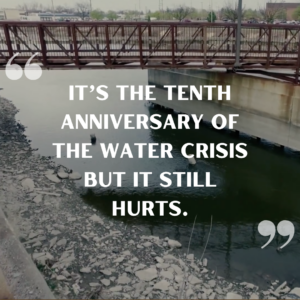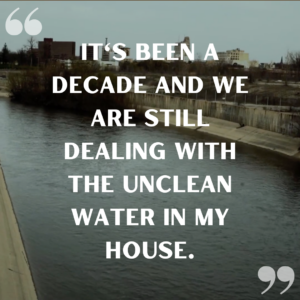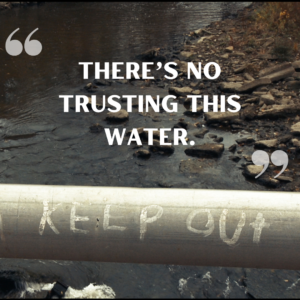
In 2014, Presbyterian Disaster Assistance’s Associate for Story Ministry, David Barnhart, met Lisa Horne, Director of Community Ministry at First Presbyterian Church of Flint, working on what would become the award-winning documentary, Flint: The Poisoning of an American City.
Barnhart recalls, “I will never forget the first time we met Lisa in her office. As we came in the front door there was a long line of people and families with children waiting down the hall to meet with her. We knew immediately that Lisa was someone who could give us insight and a perspective on this that no one else could. We have become good friends, and she has helped guide the film over those 5 years working together – and we are still in conversation today.”
April 25th marks the 10 year anniversary of switching the water in Flint, Michigan.
Watch Flint: The Poisoning of an American City (which recently reached the “15 Million Streaming Milestone”) on Amazon Prime, Google Play, Apple TV, Tubi, Kanopy and Video on Demand across major cable providers. A study guide and screening kit are available on PDA’s website.

Faith to Overcome
By Lisa Horne, Director of Community Ministry at First Presbyterian Church of Flint
In 2010 I attended community meetings where there were conversations regarding a new Karegnondi Water Authority regional water system that would offer fresh water and save money for residents in Flint/Genesee County Michigan. I had heard conversations about using the Flint River as a source of drinking water, during the restructuring, however, the history of this river would make it impossible to be considered for domestic use. At least this is what I thought until April 25, 2014, when “the switch” to using water from the Flint River started a public health crisis that I could not believe.
In my profession as a Clinical Social Worker, I have studied trauma and its impact on the lives of those who experience it therefore the environmental trauma that hit the Flint community 10 years ago has left scars despite the healing efforts. In the role of Director of Community Ministries and Outreach and a member of the community, I have heard statements such as: “It’s the tenth anniversary of the water crisis but it still hurts;” “It’s been a decade and we are still dealing with the unclean water in my house,” and “there’s no trusting this water.” It is still difficult to comprehend but reality.

Ten years after the start of the water crisis, clean water flows in the city’s water pipes that have been replaced, but according to some of the residents in Flint “the water and the pipes in my home are the same.” It is evident that the wounds inflicted by the lead poisoning from the Flint River are still causing pain in our community and there is still the question of trust and healing. I am still saddened by hearing the words of a pregnant mother during that time question the health of her unborn child because she drank one of the world’s necessities for life, water.
In a study by Wang et al (2022), published in the Journal of Population Economics*, the researchers found that the children born to mothers exposed to the contaminated water in Flint had a significantly lower birth weight on average compared to those in other cities. They found that Black babies have been disproportionately impacted by the exposure and on occasions, the epidemic has been called a crisis that resulted from systemic racism. The healing for Flint is in motion as the prayers for leadership, finances, education, public health reform, racial healing, and solidarity erupt!
This is where my faith is activated. “And the God of all grace, who called you to His eternal glory in Christ, after you have suffered a little while, will Himself restore you and make you strong, firm and steadfast” (1 Peter 5:10). The community, through many collaborative efforts, has met some of the needs of residents and continues to build hope for a healthier future for our community. The psychological distress that I have personally experienced is evident from the work I am called to do and will require more time for healing the community as we all unite and develop the practical principle of working together for the good of our community because we love the Lord and are called according to His purpose.
In closing when I am asked where we are now, I reply further along than where we were and will continue to overcome. I am reminded of Philippians chapter one where Paul and Timothy, passionate servants of Christ, write a letter to all Philippi Christians, including the pastors, and preachers. They first welcome all with God’s grace and Jesus’ peace, then they write:
“Every time you cross my mind, I break out in exclamations of thanks to God. Each exclamation is a trigger to prayer. I find myself praying for you with a glad heart. I am so pleased that you have continued in this with us, believing and proclaiming God’s Message, from the day you heard it right up to the present. There has never been the slightest doubt in my mind that the God who started this great work in you would keep at it and bring it to a flourishing finish on the very day Christ Jesus appears.” (The Message Bible online, 2018).
As the news has reported, to some there has been no justice based upon the legal system. I choose to hold on to the confession of my faith that God is still working things out for our community. I believe that the additional prayers for change, restoration, revival, and leadership working together in Flint, Michigan will be answered. To God be the glory for the things we will do!
Further reading:
USA Today: 10 years after lead poisoning, Flint residents still haven’t been paid from $626.25M fund
Bridge Michigan: Judge holds Flint in contempt for continued lead pipe replacement delays
Presbyterian News Service: Flint film aims to tell truth of the water crisis with residents’ voices
*Wang, R., Chen, X. & Li, X. Something in the pipe: the Flint water crisis and health at birth. Journal of Population Economics 35, 1723–1749 (2022). https://doi.org/10.1007/s00148-021-00876-9
